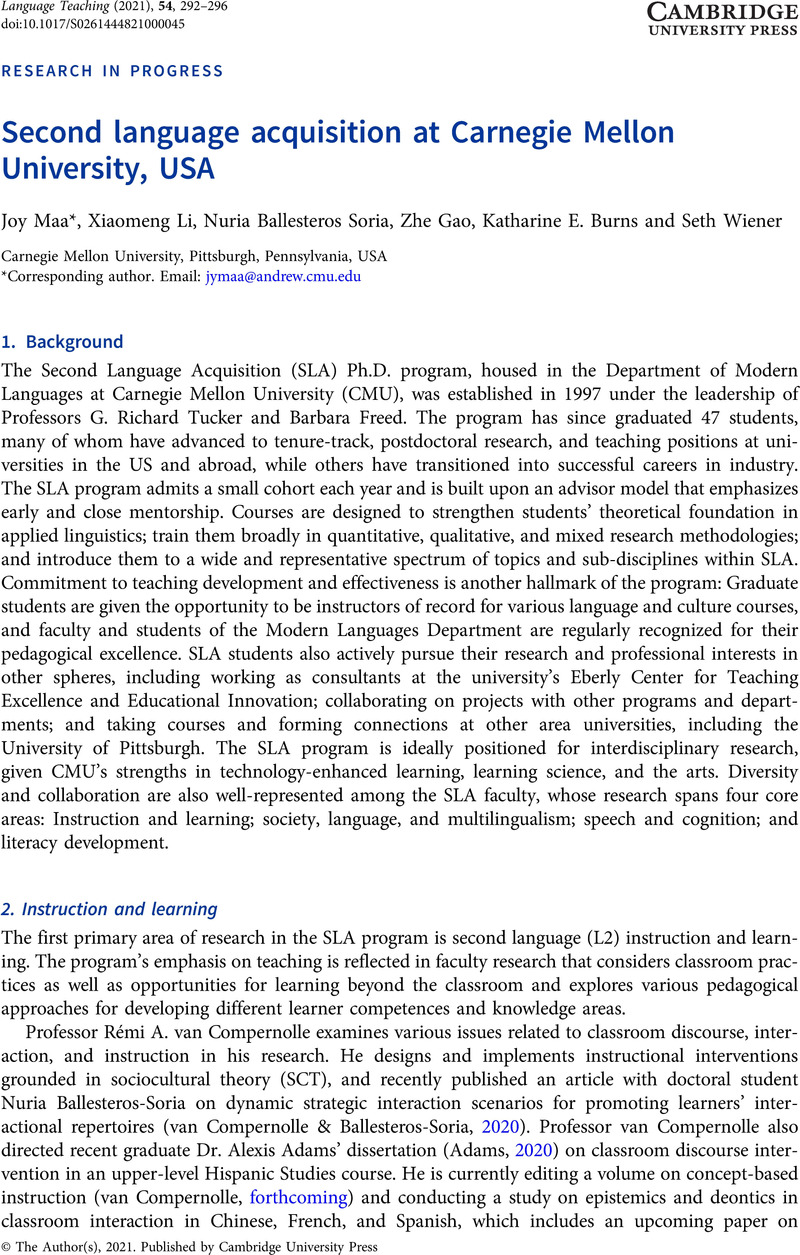No CrossRef data available.
Article contents
Second language acquisition at Carnegie Mellon University, USA
Published online by Cambridge University Press: 22 March 2021
Abstract
An abstract is not available for this content so a preview has been provided. Please use the Get access link above for information on how to access this content.

- Type
- Research in Progress
- Information
- Copyright
- Copyright © The Author(s), 2021. Published by Cambridge University Press
References
Adams, A. (2020). Cycles of expansive learning: An activity theory intervention in classroom discourse in an upper-level L2 Hispanic Studies course (Unpublished doctoral dissertation). Carnegie Mellon University, Pittsburgh, Pennsylvania, USA.Google Scholar
Al Masaeed, K. (2020). Translanguaging practices in L2 Arabic study abroad: Beyond monolingual ideologies in institutional talk. Modern Language Journal, 104(1), 250–266.CrossRefGoogle Scholar
Burns, K. E. (2018). Marginalization of local varieties in the L2 classroom: The case of U.S. Spanish. L2 Journal, 10(1), 20–38.CrossRefGoogle Scholar
Burns, K. E., & Waugh, L. R. (2018). Mixed messages in the SHL classroom: Insights from CDA of textbooks and instructor focus group discussions. Heritage Language Journal, 15(1), 1–24.CrossRefGoogle Scholar
Dubreil, S. (2020). Using games for language learning in the age of social distancing. Foreign Language Annals, 53 (Special Issue). doi:10.1111/flan.12465CrossRefGoogle Scholar
Dubreil, S., & Thorne, S. L. (2017). Engaging the world: Social pedagogies and language learning. Boston, MA: Cengage.Google Scholar
Gao, Z. (2020). L2 learning of opaque Chinese compounds through elaborative encoding. Chinese as a Second Language, 55(1), 1–23.Google Scholar
Ke, S., Miller, R., Zhang, D., & Koda, K. (2021). Crosslinguistic Sharing of Morphological Awareness in Biliteracy Development: A Systematic Review and Meta‐Analysis of Correlation Coefficients. Language Learning, 71(1), 8–54. doi: 10.1111/lang.12429CrossRefGoogle Scholar
Koda, K., & Miller, R. (Eds.). (forthcoming). The Routledge handbook of second language acquisition and reading. London, UK: Routledge.Google Scholar
MacWhinney, B. (2015). Multidimensional SLA. In Eskilde, S., & Cadierno, T. (Eds.), Usage-based perspectives on second language learning (pp. 22–45). New York, NY: Oxford University Press.Google Scholar
MacWhinney, B. (2020). Talkbank for SLA. In Tracy-Ventura, N., & Paquot, M. (Eds.), The handbook of SLA and corpora (pp. 158–174). New York, NY: Routledge.Google Scholar
Malinowski, D., Maxim, H., & Dubreil, S. (Eds.). (forthcoming). Language teaching in the linguistic landscape: Mobilizing pedagogy in public space. New York, NY: Springer.Google Scholar
Nassif, L., & Al Masaeed, K. (2020). Supporting the sociolinguistic repertoire of emergent diglossic speakers: Multidialectal practices of advanced L2 Arabic learners. Journal of Multilingual and Multicultural Development.CrossRefGoogle Scholar
Qin, T., & van Compernolle, R. A. (forthcoming). Computerized dynamic assessment of implicature comprehension in L2 Chinese. Language Learning & Technology.Google Scholar
Sykes, J., & Dubreil, S. (2019). Pragmatics learning in digital games and virtual environments. In Taguchi, N. (Ed.), The Routledge handbook of second language acquisition and pragmatics (pp. 387–399). London, UK: Routledge.CrossRefGoogle Scholar
Ulysse, G. M., & Al Masaeed, K. (forthcoming). The influence of socio-economic status, age, gender, and level of literacy on language attitudes: The case of Haitian Gonâviens. Journal of Pidgin and Creole Languages.Google Scholar
van Compernolle, R. A. (Ed.). (forthcoming). Concept-based language instruction: Principles and applications. Amsterdam/Philadelphia: John Benjamins.Google Scholar
van Compernolle, R. A. (forthcoming). Topic management and opportunities for learning in an advanced Francophone Cultures class. Applied Pragmatics.Google Scholar
van Compernolle, R. A. (2019). Constructing a second language sociolinguistic repertoire: A sociocultural usage-based approach. Applied Linguistics, 40(6), 871–893.CrossRefGoogle Scholar
van Compernolle, R. A., & Ballesteros-Soria, N. (2020). Developing interactional repertoires in the classroom through dynamic strategic interaction scenarios. Vigo International Journal of Applied Linguistics, 17, 141–169.Google Scholar
Wiener, S., & Goss, S. (2019). Second and third language learners’ sensitivity to Japanese pitch accent is additive: An information-based model of pitch perception. Studies in Second Language Acquisition, 41(4), 897–910.CrossRefGoogle Scholar
Wiener, S., Murphy, T. K., Goel, A., Christel, M. G., & Holt, L. L. (2019). Incidental learning of non-speech auditory analogs scaffolds second language learners’ perception and production of Mandarin lexical tones. In Proceedings of 19th International Congress of Phonetic Sciences, Melbourne, Australia 2019 (pp. 1699–1703).Google Scholar
Zhao, H., & MacWhinney, B. (2018). The instructed learning of form-function mappings in the English Article System. Modern Language Journal, 102(1), 99–119.CrossRefGoogle Scholar



